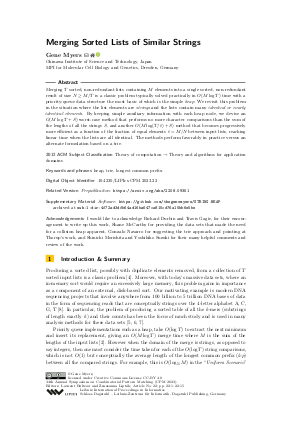Merging Sorted Lists of Similar Strings
Author
Gene Myers 
-
Part of:
Volume:
34th Annual Symposium on Combinatorial Pattern Matching (CPM 2023)
Part of: Series: Leibniz International Proceedings in Informatics (LIPIcs)
Part of: Conference: Annual Symposium on Combinatorial Pattern Matching (CPM) - License:
 Creative Commons Attribution 4.0 International license
Creative Commons Attribution 4.0 International license
- Publication Date: 2023-06-21
File

PDF
LIPIcs.CPM.2023.22.pdf
- Filesize: 0.74 MB
- 15 pages
Document Identifiers
Related Versions
- Prepublication https://arxiv.org/abs/2208.09351
Subject Classification
ACM Subject Classification
- Theory of computation → Theory and algorithms for application domains
Keywords
- heap
- trie
- longest common prefix
Metrics
- Access Statistics
-
Total Accesses (updated on a weekly basis)
0PDF Downloads0Metadata Views
Abstract
Merging T sorted, non-redundant lists containing M elements into a single sorted, non-redundant result of size N ≥ M/T is a classic problem typically solved practically in O(M log T) time with a priority-queue data structure the most basic of which is the simple heap. We revisit this problem in the situation where the list elements are strings and the lists contain many identical or nearly identical elements. By keeping simple auxiliary information with each heap node, we devise an O(M log T+S) worst-case method that performs no more character comparisons than the sum of the lengths of all the strings S, and another O(M log (T/e¯)+S) method that becomes progressively more efficient as a function of the fraction of equal elements e¯ = M/N between input lists, reaching linear time when the lists are all identical. The methods perform favorably in practice versus an alternate formulation based on a trie.
Cite As Get BibTex
Gene Myers. Merging Sorted Lists of Similar Strings. In 34th Annual Symposium on Combinatorial Pattern Matching (CPM 2023). Leibniz International Proceedings in Informatics (LIPIcs), Volume 259, pp. 22:1-22:15, Schloss Dagstuhl – Leibniz-Zentrum für Informatik (2023)
https://doi.org/10.4230/LIPIcs.CPM.2023.22
BibTex
@InProceedings{myers:LIPIcs.CPM.2023.22,
author = {Myers, Gene},
title = {{Merging Sorted Lists of Similar Strings}},
booktitle = {34th Annual Symposium on Combinatorial Pattern Matching (CPM 2023)},
pages = {22:1--22:15},
series = {Leibniz International Proceedings in Informatics (LIPIcs)},
ISBN = {978-3-95977-276-1},
ISSN = {1868-8969},
year = {2023},
volume = {259},
editor = {Bulteau, Laurent and Lipt\'{a}k, Zsuzsanna},
publisher = {Schloss Dagstuhl -- Leibniz-Zentrum f{\"u}r Informatik},
address = {Dagstuhl, Germany},
URL = {https://drops.dagstuhl.de/entities/document/10.4230/LIPIcs.CPM.2023.22},
URN = {urn:nbn:de:0030-drops-179763},
doi = {10.4230/LIPIcs.CPM.2023.22},
annote = {Keywords: heap, trie, longest common prefix}
}
Author Details
Acknowledgements
I would like to acknowledge Richard Durbin and Travis Gagie, for their encouragement to write up this work, Shane McCarthy for providing the data sets that made the need for a collision heap apparent, Gonzalo Navarro for suggesting the trie approach and pointing at Thorup’s work, and Shinichi Morishita and Yoshihiko Suzuki for their many helpful comments and review of the work.
Supplementary Materials
-
Software
https://github.com/thegenemyers/STRING.HEAP
browse
 archived version
archived version
References
-
A. Amir, G. Franceschini, R. Grossi, T. Kopelowitz, M. Lewenstein, and N. Lewenstein. Managing unbounded-length keys in comparison-driven data structures with application to online indexing. SIAM J. on Computing, 43:1396-1416, 2014.

-
T.H. Cormen, C.E. Leiserson, R.L. Rivest, and C. Stein. Introduction to Algorithms. MIT Press, 2009.

-
E. Fredkin. Trie memory. Comm. of the ACM, 3:490-499, 1960.

-
Donals E. Knuth. The Art of Computer Programming Vol. 3. Addison Wesley, 1998.

-
M. Kokot, M. Dlugosz, and S. Deorowicz. Kmc3: Counting and manipulating k-mer statistics. Bioinformatics, 33:2759-2761, 2017.

-
G. Marcais and C. Kingsford. A fast, lock-free approach for efficient parallel counting of occurrences of k-mers. Bioinformatics, 27:764-770, 2011.

- Eugene Myers. https://github.com/thegenemyers/FASTK, 2020.
-
Arang Rhie, Shane McCarthy, Olivier Frederigo, (others), Eugene Myers, Richard Durbin, Adam Phillippy, and Erich Jarvis. Towards complete and error-free genome assemblies of all vertebrate species. Nature, 592:737-746, 2021.

-
M. Thorup. On ram priority queues. SIAM J. on Computing, 30:86-109, 2000.

-
P. van Emde Boas, R. Kaas, , and E. Zijlstra. Design and implementation of an efficient priority queue. Mathematics Systems Theory, 10:99-127, 1977.

